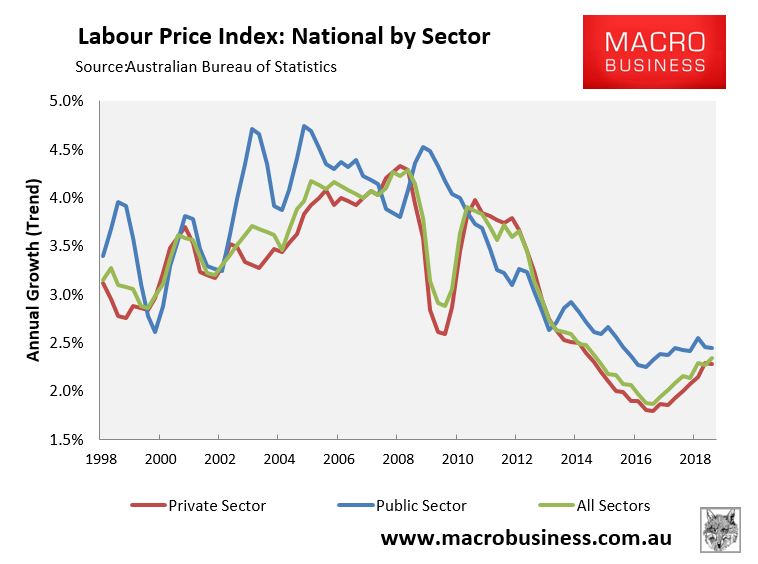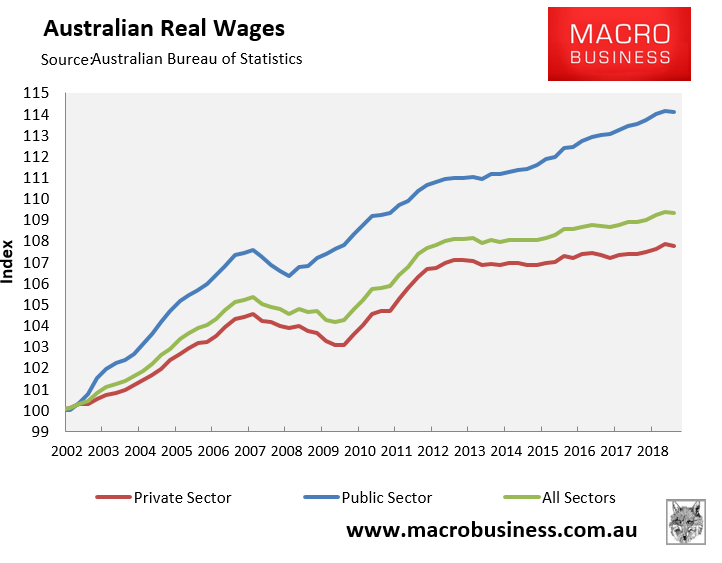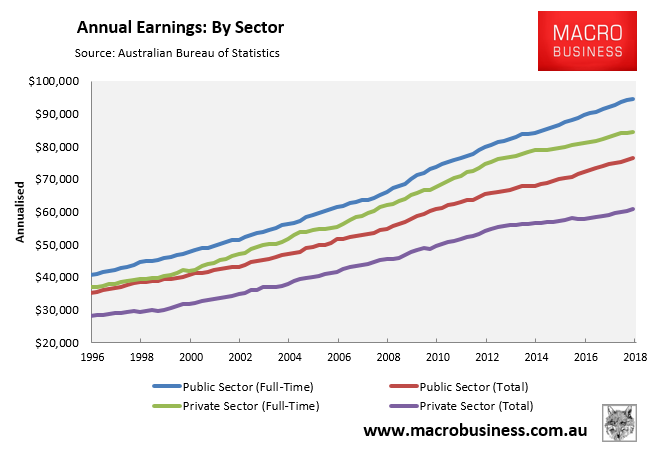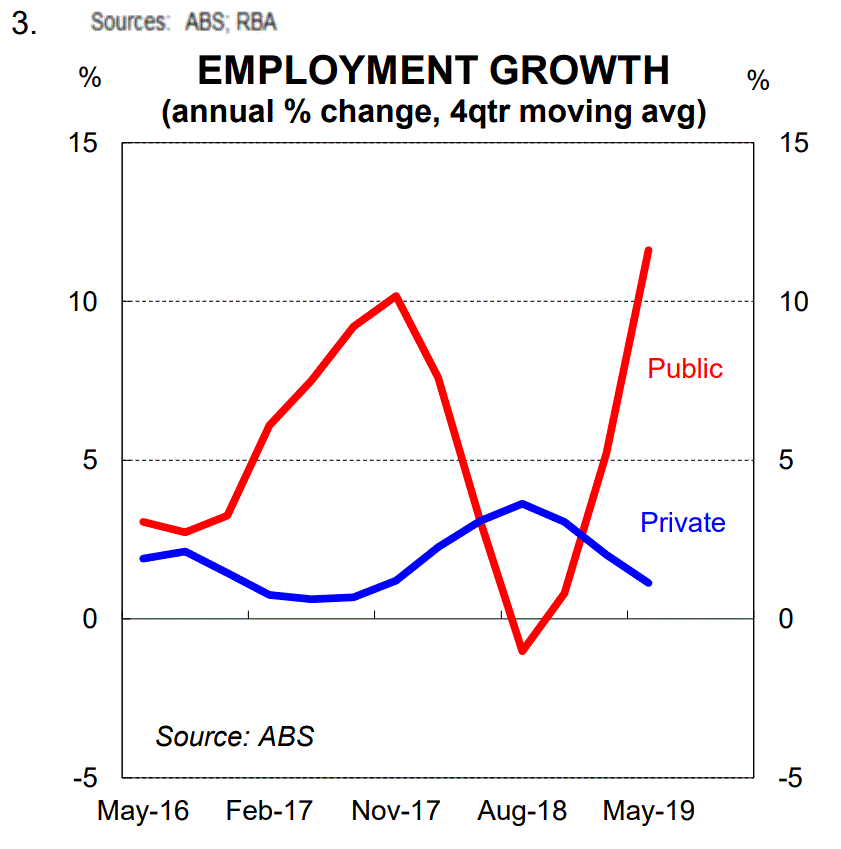Last month we witnessed Labor’s shadow financial services minister, Stephen Jones, demanding the federal government stimulate the economy and wage growth by lifting public sector salaries:
Mr Jones said Australians needed a pay rise and the government should “lead by example” by boosting the wages of federal workers. “The government has got a role to play in this. The government is a big employer,’’ he said…
Senator Cormann slapped down the move, arguing that federal employees were getting “reasonable and affordable” pay increases…
In Friday’s testimony to the House of Representatives Standing Committee on Economics, RBA Governor Phil Lowe gave similar sentiments:
Dr Lowe: I’ve also drawn attention in my prepared remarks to the wage caps in public sectors. Most public sectors have wage caps to 2½—some have 1½; I think in Western Australia it’s probably even lower—and I can understand why governments are doing that, because it’s important that we have budget discipline, and wages account for around 70 per cent of most state governments’ budgets, so I can understand why the state governments want to do this. On the other hand, the wage caps in the public sector are cementing low wage norms across the country, because the norm is now two to 2½ per cent, and partly that’s coming from the decisions that are taken by the state governments. So I’m hopeful that at some point the budget positions will improve sufficiently that state governments, or even the federal government, will be able to lift their wage caps… Over time, I hope the whole system, including the public sector, could see wages rising at three point something.
Mr BANDT: If it were incorporated into government wages policy to allow for public sector wages growth at three point something, that would be of assistance?
Dr Lowe : We are in a situation now where wage norms have drifted down to two to 2½ per cent. At the Reserve Bank we talk a lot about inflation expectations lowering as a result of low inflation. But what is really important is the wage norms in the country. Most people are accepting wage increases of two to 2½ per cent. And the public sector wage norm I think is to some degree influencing private sector outcomes as well—because, after all, a third of the workforce work directly or indirectly for the public sector. So I think it is an issue but, on the other side of the ledger here, it is important that state governments manage their budgets prudently. I have spoken to a number of state treasurers. They say, ‘We’d like to do more here but we’ve got a tough budget situation.’ So there is a balancing act to be completed here. But I hope that, over time, that balance could shift in a way that would allow wage..
Ms PAYNE: You’ve mentioned caps on public sector wages. Do you feel that’s an important part of slowing wage growth and household spending? Is that a lag on household spending more generally?
Dr Lowe : It’s part of the story. The public sector, directly and indirectly, employs roughly one-third of the labour force, and they’re saying wage increases across the public sector may be averaging two per cent. That has as indirect effect on the private sector, because there’s competition for workers and it reinforces the wage-norming economy at two-point something. I know that treasuries have to balance the considerations about the benefit they’d get from stronger aggregate wage growth against needing to deliver responsible, balanced budgets. Again, that’s a trade-off that our society is making through its governments, and the trade-off that they’re making is to entrench low wage norms in our country. Whether it’s the right trade-off, I’m not going to comment on that.
Ms PAYNE: No; of course.
Dr Lowe : But if they made a different trade-off and wages in the public sector were rising at three per cent, then over time I think we’d see stronger aggregate demand growth in the economy. I don’t think it would have much of a negative effect on employment; in fact, arguably it could be positive.
Today, The Australian’s Adam Creighton has hosed suggestions that public servant wages should be lifted in order to boost overall wage growth:
No doubt the 15 per cent of the workforce employed by governments are all for Lowe’s suggestion, but for the rest of us it’s a recipe for higher tax.
A bigger and higher-paid public sector is a double whammy, shifting workers into less productive work, by and large, while sapping the incentive to work and hire in the private sector — the ultimate source of our prosperity.
Wages will increase when productivity increases, not when government decrees it so. The federal government had almost 241,000 staff in June last year, the states 1.56 million, and local governments 188,000.
All up, the national wage bill for the 2018 financial year, the most recent for which we have data, was $158.6 billion, according to the Australian Bureau of Statistics. Every additional 1 per cent in wages is therefore another $1.6bn in tax a year that must be raised.
Our public servants are well paid, especially at the top, where pay is frequently double — in some cases almost triple — their British counterparts. Our Treasury secretary, on more than $893,000, receives 170 per cent more than his British equivalent, who presides over a considerably bigger department and a G8 economy almost three times the size.
Scott Morrison earns more than twice that of Boris Johnson (who makes do with less than £150,000 or $265,500), who arguably has a more difficult job, especially now as he walks the political tightrope to extricate Britain from the EU. Our chiefs of the army, navy and air force, on about $580,000, earn 90 per cent more than their British equivalents, who oversee a nuclear arsenal.
Our chief statistician, on more than $700,000, earns 90 per cent more than his British equal. And London is much more expensive than Canberra.
There were 3405 “senior executives” in the federal public sector alone last year, up from 2701 a year earlier, according to the Public Service Commission’s latest data. They earn more than the chairman of the US Federal Reserve.
It’s unclear whether the talent is commensurately higher in Canberra than Westminster as a result of the outsized remuneration. At the very least, surely we already pay enough to attract top talent.
The RBA itself has been no slouch in the pay department, having 181 economists and executives on $200,000 or more, with an average of $300,000, up from 160 staff the year before. The Productivity Commission’s entire staff was 160 last year…
Conditions in the public sector are extraordinarily generous, including 15.4 per cent superannuation, and generous dollops of “personal”, maternity, and annual leave unavailable in all but the biggest businesses.
Too right. The most recent wages price data from the ABS shows that public sector wages have grown far more strongly than the private sector over the past five years:

As well as over this century:

Public servants are also paid significantly more than their private sector counterparts:

And have experienced the strongest jobs growth:

If Labor and the RBA want to genuinely boost wages across the economy, they need to abandon their mass immigration ‘Big Australia’ fetish, which is perpetually flooding the labour market with workers, lowering workers’ bargaining power, abrogating employers from providing training, and crushing wage growth.
Making the economy a ward of the state is not a sustainable policy solution.

